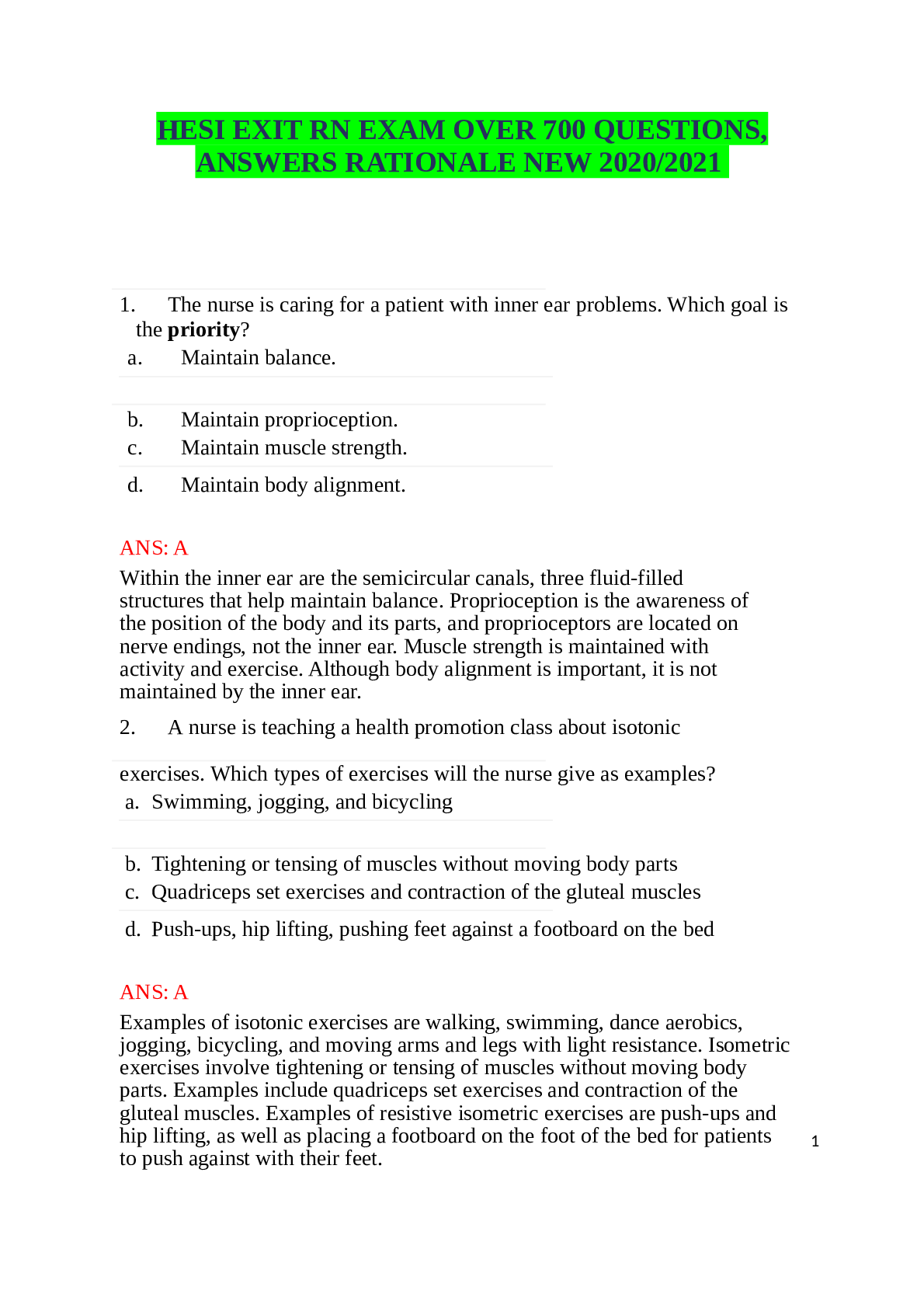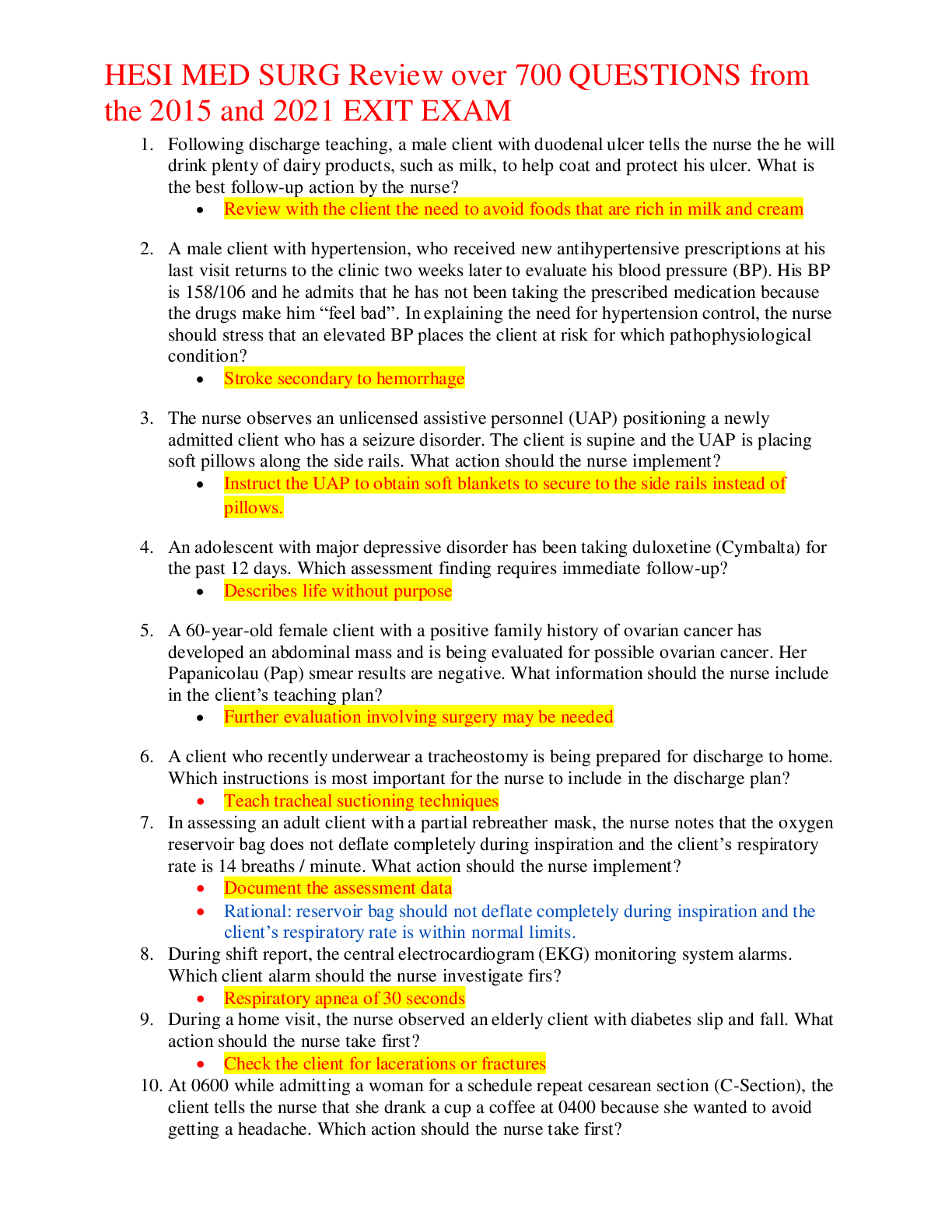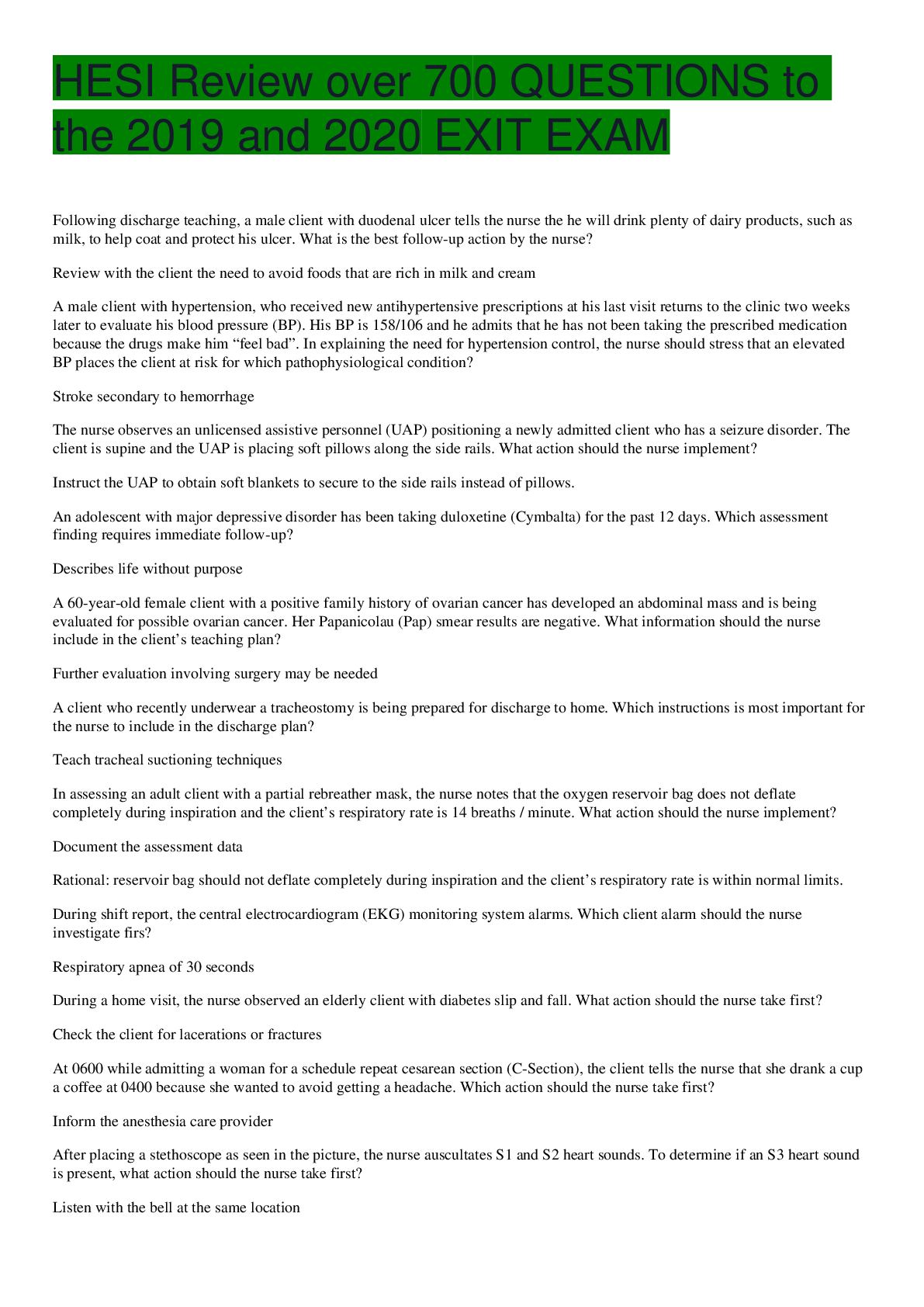Health Care > QUESTIONS & ANSWERS > [Solved] ASN 100 HESI Review over 700 QUESTIONS to the 2018 and 2018 EXIT EXAM (All)
[Solved] ASN 100 HESI Review over 700 QUESTIONS to the 2018 and 2018 EXIT EXAM
Document Content and Description Below
ASN 100 HESI Review over 700 QUESTIONS to the 2018 and 2018 EXIT EXAM • Following discharge teaching, a male client with duodenal ulcer tells the nurse the he will drink plenty of dairy... products, such as milk, to help coat and protect his ulcer. What is the best follow-up action by the nurse? • A male client with hypertension, who received new antihypertensive prescriptions at his last visit returns to the clinic two weeks later to evaluate his blood pressure (BP). His BP is 158/106 and he admits that he has not been taking the prescribed medication because the drugs make him “feel bad”. In explaining the need for hypertension control, the nurse should stress that an elevated BP places the client at risk for which pathophysiological condition? • The nurse observes an unlicensed assistive personnel (UAP) positioning a newly admitted client who has a seizure disorder. The client is supine and the UAP is placing soft pillows along the side rails. What action should the nurse implement? • An adolescent with major depressive disorder has been taking duloxetine (Cymbalta) for the past 12 days. Which assessment finding requires immediate follow-up? • A 60-year-old female client with a positive family history of ovarian cancer has developed an abdominal mass and is being evaluated for possible ovarian cancer. Her Papanicolau (Pap) smear results are negative. What information should the nurse include in the client’s teaching plan? • A client who recently underwear a tracheostomy is being prepared for discharge to home. Which instructions is most important for the nurse to include in the discharge plan? • In assessing an adult client with a partial rebreather mask, the nurse notes that the oxygen reservoir bag does not deflate completely during inspiration and the client’s respiratory rate is 14 breaths / minute. What action should the nurse implement? • During shift report, the central electrocardiogram (EKG) monitoring system alarms. Which client alarm should the nurse investigate firs? • During a home visit, the nurse observed an elderly client with diabetes slip and fall. What action should the nurse take first? • At 0600 while admitting a woman for a schedule repeat cesarean section (C-Section), the client tells the nurse that she drank a cup a coffee at 0400 because she wanted to avoid getting a headache. Which action should the nurse take first? • After placing a stethoscope as seen in the picture, the nurse auscultates S1 and S2 heart sounds. To determine if an S3 heart sound is present, what action should the nurse take first? • A 66-year-old woman is retiring and will no longer have a health insurance through her place of employment. Which agency should the client be referred to by the employee health nurse for health insurance needs? • A client who is taking an oral dose of a tetracycline complains of gastrointestinal upset. What snack should the nurse instruct the client to take with the tetracycline? • Following a lumbar puncture, a client voices several complaints. What complaint indicated to the nurse that the client is experiencing a complication? • An elderly client seems confused and reports the onset of nausea, dysuria, and urgency with incontinence. Which action should the nurse implement? • The nurse is assisting the mother of a child with phenylketonuria (PKU) to select foods that are in keeping with the child’s dietary restrictions. Which foods are contraindicated for this child? • Before preparing a client for the first surgical case of the day, a part-time scrub nurse asks the circulating nurse if a 3 minute surgical hand scrub is adequate preparation for this client. Which response should the circulating nurse provide? • Which breakfast selection indicates that the client understands the nurse’s instructions about the dietary management of osteoporosis? • The charge nurse of a critical care unit is informed at the beginning of the shift that less than the optimal number of registered nurses will be working that shift. In planning assignments, which client should receive the most care hours by a registered nurse (RN)? • A mother brings her 6-year-old child, who has just stepped on a rusty nail, to the pediatrician’s office. Upon inspection, the nurse notes that the nail went through the shoe and pierced the bottom of the child’s foot. Which action should the nurse implement first? • The mother of an adolescent tells the clinic nurse, “My son has athlete’s foot, I have been applying triple antibiotic ointment for two days, but there has been no improvement.” What instruction should the nurse provide? • A 26-year-old female client is admitted to the hospital for treatment of a simple goiter, and levothyroxine sodium (Synthroid) is prescribed. Which symptoms indicate to the nurse that the prescribed dosage is too high for this client? The client experiences • Bradycardia and constipation • Lethargy and lack of appetite • Muscle cramping and dry, flushed skin • A client with a history of heart failure presents to the clinic with a nausea, vomiting, yellow vision and palpitations. Which finding is most important for the nurse to assess to the client? The healthcare provider prescribes an IV solution of isoproterenol (Isuprel) 1 mg in 250 ml of D • W at 300 mcg/hour. The nurse should program the infusion pump to deliver how many ml/hour? (Enter numeric value only.) • The pathophysiological mechanism are responsible for ascites related to liver failure? (Select all that apply) • The nurse is auscultating a client’s heart sounds. Which description should the nurse use to document this sound? (Please listen to the audio first to select the option that applies) • The healthcare provider prescribes celtazidime (Fortax) 35 mg every 8 hours IM for an infant. The 500 mg vial is labeled with the instruction to add 5.3 ml diluent to provide a concentration of 100 mg/ml. How many ml should the nurse administered for each dose? (Enter numeric value only. If rounding is required, round to the nearest tenth) • The nurse notes that a client has been receiving hydromorphone (Dilaudid) every six hours for four days. What assessment is most important for the nurse to complete? • A female client is admitted with end stage pulmonary disease is alert, oriented, and complaining of shortness of breath. The client tells the nurse that she wants “no heroic measures” taken if she stops breathing, and she asks the nurse to document this in her medical record. What action should the nurse implement? • A client is receiving a full strength continuous enteral tube feeding at 50 ml/hour and has developed diarrhea. The client has a new prescription to change the feeding to half strength. What intervention should the nurse implement? • A female client reports that her hair is becoming coarse and breaking off, that the outer part of her eyebrows have disappeared, and that her eyes are all puffy. Which follow-up question is best for the nurse to ask? • • After a third hospitalization 6 months ago, a client is admitted to the hospital with ascites and malnutrition. The client is drowsy but responding to verbal stimuli and reports recently spitting up blood. What assessment finding warrants immediate intervention by the nurse? • bruises on arms and legs • round and tight abdomen • pitting edema in lower legs • After the nurse witnesses a preoperative client sign the surgical consent form, the nurse signs the form as a witness. What are the legal implications of the nurse’s signature on the client’s surgical consent form? (Select all that apply) • Following surgery, a male client with antisocial personality disorder frequently requests that a specific nurse be assigned to his care and is belligerent when another nurse is assigned. What action should the charge nurse implement? • A client with cervical cancer is hospitalized for insertion of a sealed internal cervical radiation implant. While providing care, the nurse finds the radiation implant in the bed. What action should the nurse take? • The client with which type of wound is most likely to need immediate intervention by the nurse? • • The nurse is planning care for a client admitted with a diagnosis of pheochromocytoma. Which intervention has the highest priority for inclusion in this client’s plan of care? • • When caring for a client who has acute respiratory distress syndrome (ARDS), the nurse elevates the head of the bed 30 degrees. What is the reason for this intervention? • When assessing a mildly obese 35-year-old female client, the nurse is unable to locate the gallbladder when palpating below the liver margin at the lateral border of the rectus abdominal muscle. What is the most likely explanation for failure to locate the gallbladder by palpation? • The client is too obese • Palpating in the wrong abdominal quadrant • Deeper palpation technique is needed • A woman with an anxiety disorder calls her obstetrician’s office and tells the nurse of increased anxiety since the normal vaginal delivery of her son three weeks ago. Since she is breastfeeding, she stopped taking her antianxiety medications, but thinks she may need to start taking them again because of her increased anxiety. What response is best for the nurse to provide this woman? • An older male client with a history of type 1 diabetes has not felt well the past few days and arrives at the clinic with abdominal cramping and vomiting. He is lethargic, moderately, confused, and cannot remember when he took his last dose of insulin or ate last. What action should the nurse implement first? • obtain a serum potassium level • administer the client's usual dose of insulin • assess pupillary response to light • A client who received multiple antihypertensive medications experiences syncope due to a drop in blood pressure to 70/40. What is the rationale for the nurse’s decision to hold the client’s scheduled antihypertensive medication? • an older client who attempted 1 month ago • a young adult who takes antipsychotic medications twice a day • a middle-aged woman who uses a tank for supplemental oxygen • An African-American senior citizens center • A daycare center in a Hispanic neighborhood • An after-school center for Native-American teens • working together can decrease the risk for back injury • Using two or three people increases client safety. • turning instead of pulling reduces the likelihood of skin damage • contact precautions • droplet precautions • protective environment • When preparing to discharge a male client who has been hospitalized for an adrenal crisis, the client expresses concern about having another crisis. He tells the nurse that he wants to stay in the hospital a few more days. Which intervention should the nurse implement? • An adult female client tells the nurse that though she is afraid her abusive boyfriend might one day kill her, she keeps hoping that he will change. What action should the nurse take first? • In caring for a client with Cushing syndrome, which serum laboratory value is most important for the nurse to monitor? • Lactate • Hemoglobin • Creatinine • Azithromycin is prescribed for an adolescent female who has lower lobe pneumonia and recurrent chlamydia. What information is most important for the nurse to provide to this client? • A client in the emergency center demonstrates rapid speech, flight of ideas, and reports sleeping only three hours during the past 48h. Based on these finding, it is most important for the nurse to review the laboratory value for which medication? • A male client who is admitted to the mental health unit for treatment of bipolar disorder has a slightly slurred speech pattern and an unsteady gait. Which assessment finding is most important for the nurse to report to the healthcare provider? • A client was admitted to the cardiac observation unit 2 hours ago complaining of chest pain. On admission, the client’s EKG showed bradycardia, ST depression, but no ventricular ectopy. The client suddenly reports a sharp increase in pain, telling the nurse, “I feel like an elephant just stepped on my chest” The EKG now shows Q waves and ST segment elevations in the anterior leads. What intervention should the nurse perform? • The nurse is developing a teaching program for the community. What population characteristic is most influential when choosing strategies for implementing a teaching plan? • A client is being discharged with a prescription for warfarin (Coumadin). What instruction should the nurse provide this client regarding diet? • A client who had a small bowel resection acquired methicillin resistant staphylococcus aureus (MRSA) while hospitalized. He treated and released, but is readmitted today because of diarrhea and dehydration. It is most important for the nurse to implement which intervention. • A postoperative female client has a prescription for morphine sulfate 10 mg IV q3 hours for pain. One dose of morphine was administered when the client was admitted to the post anesthesia care unit (PACU) and 3 hours later, the client is again complaining of pain. Her current respiratory rate is 8 breaths/minute. What action should the nurse take? • Which intervention is most important for the nurse to include in the plan of care for an older woman with osteoporosis? • Based on the information provided in this client’s medical record during labor, which should the nurse implement? (Click on each chart tab for additional information. Please be sure to scroll to the bottom right corner of each tab to view all information contained in the client’s medical record.) • An unlicensed assistive personnel UAP leaves the unit without notifying the staff. In what order should the unit manager implement this intervention to address the UAPs behavior? (Place the action in order from first on top to last on bottom.) • A client with intestinal obstructions has a nasogastric tube to low intermittent suction and is receiving an IV of lactated ringer’s at 100 ml/H. which finding is most important for the nurse to report to the healthcare provider? • Which type of Leukocyte is involved with allergic responses and the destruction of parasitic worms? • Neutrophils • Lymphocytes • Monocytes • The healthcare provider prescribes the antibiotic cephradine 500mg PO every 6 hours for a client with a postoperative wound infection. Which foods should the nurse encourage this client to eat? • Several months after a foot injury, and adult woman is diagnosed with neuropathic pain. The client describes the pain as severe and burning and is unable to put weight on her foot. She asks the nurse when the pain will “finally go away.” How should the nurse respond? • One day following an open reduction and internal fixation of a compound fracture of the leg, a male client complains of “a tingly sensation” in his left foot. The nurse determines the client’s left pedal pulses are diminished. Based on these finding, what is the client’s greatest risk? • The nurse is completing a head to be assessment for a client admitted for observation after falling out of a tree. Which finding warrants immediate intervention by the nurse? • A client with multiple sclerosis (MS) has decreased motor function after taking a hot bath (Uhthoff’s sign). Which pathophysiological mechanism supports this response? • While assessing a radial artery catheter, the client complains of numbness and pain distal to the insertion site. What interventions should the nurse implement? • A client is admitted with an epidural hematoma that resulted from a skateboarding accident. To differentiate the vascular source of the intracranial bleeding, which finding should the nurse monitor? • The nurse finds a client at 33 weeks gestation in cardiac arrest. What adaptation to cardiopulmonary resuscitation (CPR) should the nurse implement? • When preparing a client for discharge from the hospital following a cystectomy and a urinary diversion to treat bladder cancer, which instruction is most important for the nurse to include in the client’s discharge teaching plan? • For the past 24 hours, an antidiarrheal agent, diphenoxylate, has been administered to a bedridden, older client with infectious gastroenteritis. Which finding requires the nurse to take further action? • After repositioning an immobile client, the nurse observes an area of hyperemia. To assess for blanching, what action should the nurse take? • The nurse enters a client’s room and observes the client’s wrist restraint secured as seen in the picture. What action should the nurse take? • A female client with acute respiratory distress syndrome (ARDS) is chemically paralyzed and sedated while she is on as assist-control ventilator using 50% FIO2. Which assessment finding warrants immediate intervention by the nurse? • The development of atherosclerosis is a process of sequential events. Arrange the pathophysiological events in orders of occurrence. (Place the first event on top and the last on the bottom) • Following a motor vehicle collision, an adult female with a ruptured spleen and a blood pressure of 70/44, had an emergency splenectomy. Twelve hours after the surgery, her urine output is 25 ml/hour for the last two hours. What pathophysiological reason supports the nurse’s decision to report this finding to the healthcare provider? • A nurse-manager is preparing the curricula for a class for charge nurses. A staffing formula based on what data ensures quality client care and is most cost-effective? • When performing postural drainage on a client with Chronic Obstructive Pulmonary Disease (COPD), which approach should the nurse use? • A client presents in the emergency room with right-sided facial asymmetry. The nurse asks the client to perform a series of movements that require use of the facial muscles. What symptoms suggest that the client has most likely experience a Bell’s palsy rather than a stroke? • The nurse is teaching a client how to perform colostomy irrigations. When observing the client’s return demonstration, which action indicated that the client understood the teaching? • The nurse should teach the client to observe which precaution while taking dronedarone? • A client who sustained a head injury following an automobile collision is admitted to the hospital. The nurse include the client’s risk for developing increased intracranial pressure (ICP) in the plan of care. Which signs indicate to the nurse that ICP has increased? • Increased Glasgow coma scale score. • Nuchal rigidity and papilledema. • Periorbital ecchymosis. • The nurse is caring for a client receiving continuous IV fluids through a single lumen central venous catheter (CVC). Based on the CVC care bundle, which action should be completed daily to reduce the risk for infection? • • During an annual physical examination, an older woman’s fasting blood sugar (FBS) is determined to be 140 mg/dl or 7.8 mmol/L (SI). Which additional finding obtained during a follow-up visit 2 weeks later is most indicative that the client has diabetes mellitus (DM)? • A new mother tells the nurse that she is unsure if she will be able to transition into parenthood. What action should the nurse take? • A client who was admitted yesterday with severe dehydration is complaining of pain a 24 gauge IV with normal saline is infusing at a rate of 150 ml/hour. Which intervention should the nurse implement first? • An elderly female is admitted because of a change in her level of sensorium. During the evening shift, the client attempts to get out bed and falls, breaking her left hip. Buck’s skin traction is applied to the left leg while waiting for surgery. Which intervention is most important for the nurse to include in this client’s plan care? • An Unna boot is applied to a client with a venous stasis ulcer. One week later, when the Unna boot is removed during a follow-up appointment, the nurse observes that the ulcer site contains bright red tissue. What action should the nurse take in response to this finding? • At the end of a preoperative teaching session on pain management techniques, a client starts to cry and states, “I just know I can’t handle all the pain.” What is the priority nursing diagnosis for this client? • The nurse note a visible prolapse of the umbilical cord after a client experiences spontaneous rupture of the membranes during labor. What intervention should the nurse implement immediately? • A client who had a right hip replacement 3 day ago is pale has diminished breath sound over the left lower lung fields, a temperature of 100.2 F, and an oxygen saturation rate of 90%. The client is scheduled to be transferred to a skilled nursing facility (SNF) tomorrow for rehabilitative critical pathway. Based on the client’s symptoms, what recommendation should the nurse give the healthcare provider? • A client who is newly diagnosed with type 2 diabetes mellitus (DM) receives a prescription for metformin (Glucophage) 500 mg PO twice daily. What information should the nurse include in this client’s teaching plan? (Select all that apply.) • The nurse is developing an educational program for older clients who are being discharged with new antihypertensive medications. The nurse should ensure that the educational materials include which characteristics? Select all that apply • Written at a twelfth grade reading level • Printed using a 12 point type font • During the admission assessment, the nurse auscultates heart sounds for a client with no history of cardiovascular disease. Where should the nurse listen when assessing the client’s point of maximal impulse (PMI) (Click the chosen location. To change, click on a new location) • • An older male adult resident of long-term care facility is hospitalized for a cardiac catheterization that occurred yesterday. Since the procedure was conducted, the client has become increasingly disoriented. The night shift nurse reports that he attempted to remove the sandbag from his femoral artery multiple times during the night. What actions should the nurse take? (Select all that apply.) • An older male comes to the clinic with a family member. When the nurse attempts to take the client’s health history, he does not respond to questions in a clear manner. What action should the nurse implement first? • The nurse caring for a client with acute renal fluid (ARF) has noted that the client has voided 800 ml of urine in 4 hours. Based on this assessment, what should the nurse anticipate that client will need? • Which intervention should the nurse include in the plan of care for a child with tetanus? • Suicide precautions are initiated for a child admitted to the mental health unit following an intentional narcotic overdose. After a visitor leaves, the nurse finds a package of cigarettes in the client’s room. Which intervention is most important for the nurse to implement? • A family member of a frail elderly adult asks the nurse about eligibility requirements for hospice care. What information should the nurse provide? (Select all that apply.) • A client with atrial fibrillation receives a new prescription for dabigatran. What instruction should the nurse include in this client’s teaching plan? • A nurse with 10 years experience working in the emergency room is reassigned to the perinatal unit to work an 8 hour shift. Which client is best to assign to this nurse? • An infant who is admitted for surgical repair of a ventricular septal defect (VSD) is irritable and diaphoretic with jugular vein distention. Which prescription should the nurse administer first? • The nursing staff on a medical unit includes a registered nurse (RN), practical nurse (PN), and an unlicensed assistive personnel (UAP). Which task should the charge nurse assign to the RN? • While teaching a young male adult to use an inhaler for his newly diagnosed asthma, the client stares into the distance and appears to be concentrating on something other than the lesson the nurse is presenting. What action should the nurse take? • After several hours of non-productive coughing, a client presents to the emergency room complaining of chest tightness and shortness of breath. History includes end stage chronic obstructive pulmonary disease (COPD) and diabetes mellitus. While completing the pulmonary assessment, the nurse hears wheezing and poor air movement bilaterally. Which actions should the nurse implement? (Select all that apply.) • The nurse caring for a 3-month-old boy one day after a pylorotomy notices that the infant is restless, is exhibiting facial grimaces, and is drawing his knees to his chest. What action should the nurse take? • A 4-year-old with acute lymphocytic leukemia (ALL) is receiving a chemotherapy (CT) protocol that includes methotrexate (Mexate, Trexal, MIX), an antimetabolite. Which information should the nurse provide the parents about caring for their child? • Two days after admission a male client remembers that he is allergic to eggs, and informs the nurse of the allergy. Which actions should the nurse implement? (Select all that apply) • The rapid response team’s detects return of spontaneous circulation (ROSC) after 2 min of continuous chest compressions. The client has a weak, fast pulse and no respiratory effort, so the healthcare provider performs a successful oral, intubation. What action should the nurse implement? • After administering an antipyretic medication. Which intervention should the nurse implement? • A client with hyperthyroidism is being treated with radioactive iodine (I-131). Which explanation should be included in preparing this client for this treatment? • After a colon resection for colon cancer, a male client is moaning while being transferred to the Postanesthesia Care Unit (PACU). Which intervention should the nurse implement first? • The nurse is caring for a group of clients with the help of a licensed practical nurse (LPN) and an experienced unlicensed assistive personnel (UAP). Which procedures can the nurse delegate to the UAP? (Select all that apply) • A male client with cirrhosis has ascites and reports feeling short of breath. The client is in semi Fowler position with his arms at his side. What action should the nurse implement? • A client with a history of chronic pain requests a nonopioid analgesic. The client is alert but has difficulty describing the exact nature and location of the pain to the nurse. Which action should the nurse implement next? • A client with a chronic health problem has difficulty ambulating short distance due to generalized weakness, but is able to bear weight on both legs. To assist with ambulation and provide the greatest stability, what assistive device is best for this client? • The nurse prepares an intravenous solution and tubing for a client with a saline lock, as seen in the video. Which nurse takes next 2. The husband of an older woman, diagnosed with pernicious anemia, calls the clinic to report that his wife still has memory loss and some confusion since she received the first dose of nasal cyanocobalamin two days ago. He tells the nurse that he is worried that she might be getting Alzheimer’s disease. What action should the nurse take? Explain that memory loss and confusion are common with vitamin B12 deficiency 3. A female client who is admitted to the mental health unit for opiate dependency is receiving clonidine 0.1 mg PO for withdrawal symptoms. The client begins to complain of feeling nervous and tells the nurse that her bones are itching. Which finding should the nurse identify as a contraindication for administering the medication? Blood pressure 90/76 mm Hg 4. During discharge teaching, an overweight client heart failure (HF) is asked to make a grocery list for the nurse to review. Which food choices included on the client’s list should the nurse encourage? (Select all that apply) A. Canned fruit in heavy syrup. B. Plain, air-popped popcorn. C. Cheddar cheese cubes. D. Natural whole almonds. E. Lightly salted potato chips 5. A client with Addison’s disease becomes weak, confused, and dehydrated following the onset of an acute viral infection. The client’s laboratory values include; sodium 129 mEq/l (129mmol/l SI), glucose 54 mg/dl (2.97mmol/l SI) and potassium 5.3 mmol/l SI). When reporting the findings to the HCP, the nurse anticipates a prescription for which intravenous medications? A. Regular insulin. B. Hydrocortisone C. Broad spectrum antibiotic D. Potassium chloride 6. An adolescent, whose mother recently died, comes to the school nurse complain headache. Which statement made by the students should warrant further explanation nurse? A. “I’ve had dreams about Mon since she died.” B. “I’ve been very sad and cry a lot at night.” C. “I miss Mon and would like to go see her’”. D. “ it’s hard to concentrate on my homework” 7. When washing soiled hands, the nurse first wets the hands and applies soap. The nurse should complete additional actions in which sequence? (Arrange from first action on top last action on bottom.) 1. Rub hands palm to palm. 2. Interlace the fingers, 3. Dry hands with paper towel. 4. Turn off the water faucet. 8. An Unna boot is applied to a client with a venous stasis ulcer. One week later, when the Unna boot is removed during a follow-up appointment, the nurse observes that the ulcer site contains bright red tissue. What action should the nurse take in response to this finding? Document the ongoing wound healing. 9. The nurse is caring for four clients who are on the rehabilitation unit, which client should the nurse assess first? A. A client with an above-the-knee amputation who is complaining of phantorn pain. B. A client who is receiving a continuous tube feeding and is now vomiting. C. A client with left hemiplegia who is scheduled for hemodialysis today. D. A client with pneumonia who is scheduled for pulmonary function studies. 10. A client’s telemetry monitor indicates ventricular fibrillation (VF). After delivering one counter shock, the nurse resumes chest compression, after another minute of compression , the client’s rhythm converts to supraventricular tachycardia (SVT) on the monitor, at this point , what is the priority intervention for the nurse? A. Prepare for transcutaneous pacing B. Administer IV epinephrine per ACLS protocol. C. Give IV dose of adenosine rapidly over 1-2 seconds. D. Deliver another defibrillator shock. 19. A client with a history of using illicit drugs intravenously is admitted with Kaposi’s sarcoma. Which intervention should the nurse include in this client’s admission plan of care? A. Identify local support HIV support groups. B. Assess for symptoms of AIDS dementia. C. Observe for adverse drug reaction. D. Monitor for secondary infections. 20. After an elderly female client receives treatment for drug toxicity, the HCP prescribes a 24- hour creatinine clearance test. Prior to starting the urine collection, the nurse notes that the client’s serum creatinine is 0.3mg/dl. What action should the nurse implement? A. Initiate the urine collection as prescribed. B. Notify the HCP of the results. C. Evaluate the client’s serum BUN level. D. Assess the client for signs of hypokalemia. 21. Immediately after extubation, a client who has been mechanically ventilated is placed on a 50% non-rebreather. The client is hoarse and complaining of a sore throat. Which assessment finding should the nurse report to the healthcare provider immediately? A. Blood tinged sputum B. Expiratory wheezing C. Upper airway stridor D. Oxygen saturations 90% 22. The nurse is collecting sterile sample for culture and sensitivity from a disposable three chamber water-seal drainage system connected to a pleural chest tube. The nurse should obtain the sample from which site on the drainage system? A. Stopper port located above the water-seal level B. Plastic tubing located at the chest insertion site C. Rubberized port at the bottom of collection chamber D. Tubbing located on the top of the suction chamber 23. While the nurse is preparing a scheduled intravenous (IV) medication, the client states that the IV site hurts and refuses to allow the nurse to administer a flush to assess the site. Which intervention should the nurse implement? A. Apply ice first, then a warm compress to the IV site B. Discontinue the painful IV after a new IV is inserted C. Review the medical record for the date of insertion D. Document that the medication was not administered 24. During a staff meeting, a nurse verbally attacks the nurse manager conducting the meeting, stating, “you always let your favorites have holidays off give then easier assignments. You are unfair and prejudiced” how should the nurse-manager respond? A. I would prefer to discuss this with you privately. B. Give me specific examples to support your statements. C. Does anyone else on the staff fell the same way D. Your remarks are not true and are very unkind 25. An adult is admitted to the emergency department following ingestion of a bottle of antidepressants secondary to chronic paint. A nasogastric tube and a left subclavian venous catheter are placed. The nurse auscultates audible breath sounds on the right side, faint sounds procedure should the nurse prepare for first? A. Insertion of a left- sided chest tube. B. Placement of an endotracheal tube. C. Retraction of the nasogastric tube D. Setup of patient- controlled analgesia 26. A client is admitted to the hospital after experiencing a brain attack, commonly referred to as a stroke or cerebral vascular accident (CVA). The nurse should request a referral for speech therapy if the client exhibits which finding? Abnormal responses for cranial nerves I and II Persistent coughing while drinking Unilateral facial drooping Inappropriate or exaggerated mood swings 27. A male client is admitted with a severe asthma attack. For the last 3 hours he has experienced increased shortness of breath. His arterial blood gas results are: pH 7.22 PaCO2 55 mmHg; HCO3 25 mEq/L or mmol/L (SI). Which intervention should the nurse implement? A. Space care to provide periods of rest B. Instruct client to purse lip breathe C. Administer PRN dose of albuterol D. Position client for maximum comfort 28. A young adult female with chronic kidney disease (CKD) due to recurring pyelonephritis is hospitalized with basilar crackles and peripheral edema. She is complaining of severe nausea and the cardiac monitor indicates sinus tachycardia with frequent premature ventricular contraction. Her blood pressure is 200 /110 mm Hg, and her temperature is 101 F which PRN medication should the nurse administers first? A. Enalapril B. Furosemide C. Acetaminophen D. Promethazine 29. When entering a client’s room to administer an 0900 IV antibiotic, the nurse finds that the client is engaged in sexual activity with a visitor. Which actions should the nurse implement? A. Ignore the behavior and hang the IV antibiotic B. tell the client to stop the inappropriate behavior C. Leave the room and close the door quietly D. Complete an unusual occurrence report 30. The nurse is caring for a client who is experiencing a tonic-clonic seizure. Which actions should the nurse implement? (Select all that apply) Ease the client to the floor Loosen restrictive clothing Note the duration of the seizure 40. A child with heart failure (HF) is taking digitalis. Which signs indicates to the nurse that the child may be experiencing digitalis toxicity? Tachycarcia Dyspnea Vomiting Muscle cramps 41. An antacid is prescribed for a client with gastroesophageal (GERD). The client asks the nurse, “How does this help my GERD?” What is the best response by the nurse? A. This medication will coat the lining of your esophagus B. Antacids will neutralize the acid in your stomach C. It will improve the emptying of food through your stomach D. antacids decrease the production of gastric secretions 42. The nurse suspect may be hemorrhaging internally. Which findings of an orthostatic test may indicate to the nurse of major bleed? A decrease in the systolic b/p of 10mm/hg with a corresponding increase of heart rate of 20. 43. A male adult is admitted because of an acetaminophen overdose. After transfer to the mental health unit, the client is told he has liver damage. Which information is most important for the nurse to include in the client’s discharge plan? A. Avoid exposure to large crowds B. Do not take any over-the-counter medications C. Call the crisis hot line if feeling lonely D. Eat a high carbohydrate, low fat, low protein diet 44. A client arrives in the emergency center with a blood alcohol level of 500 mg/dl. When transferred to the observation unit, the client becom [Show More]
Last updated: 1 year ago
Preview 1 out of 120 pages
.png)
Reviews( 1 )

by Peter-Student · 2 years ago
Document information
Connected school, study & course
About the document
Uploaded On
Dec 17, 2020
Number of pages
120
Written in
Additional information
This document has been written for:
Uploaded
Dec 17, 2020
Downloads
2
Views
74

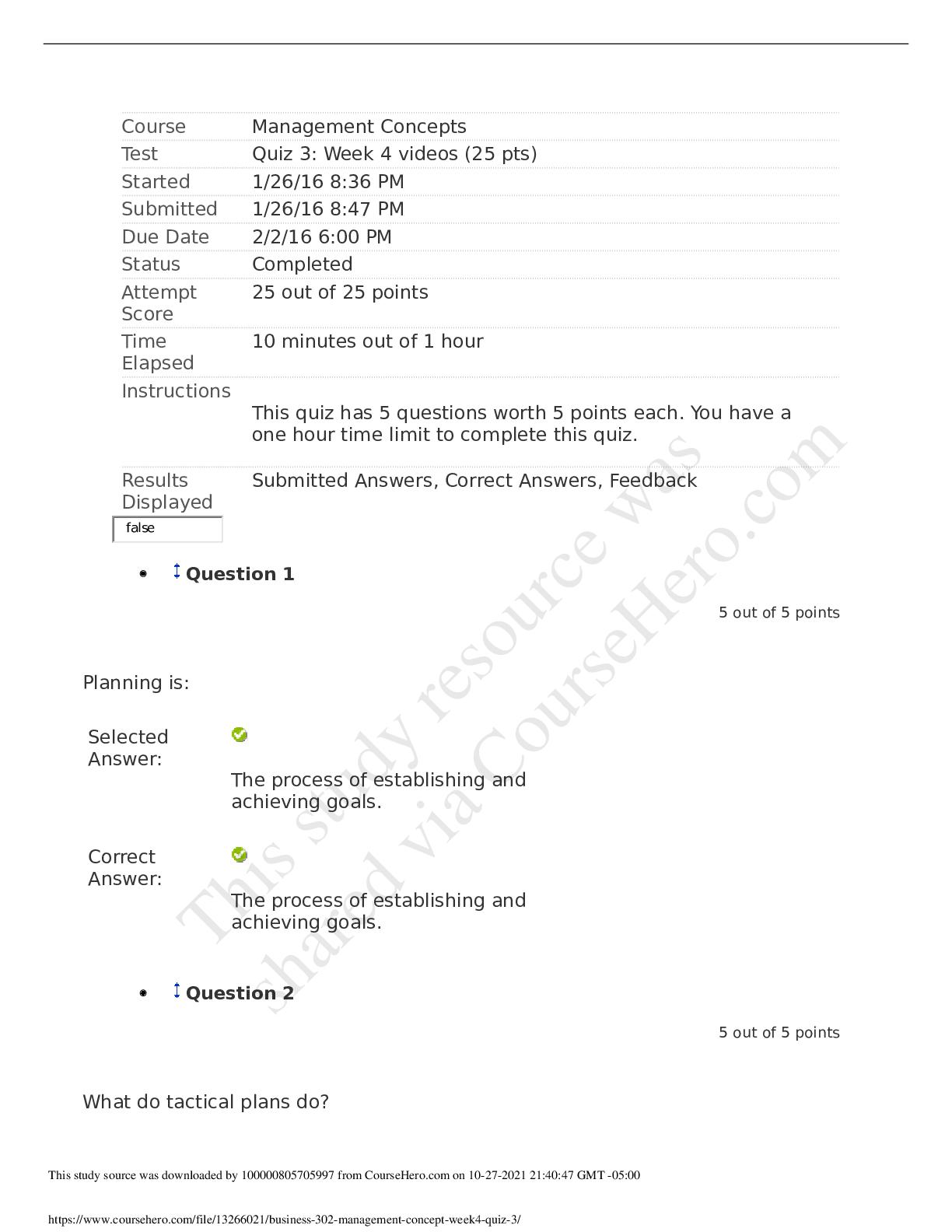
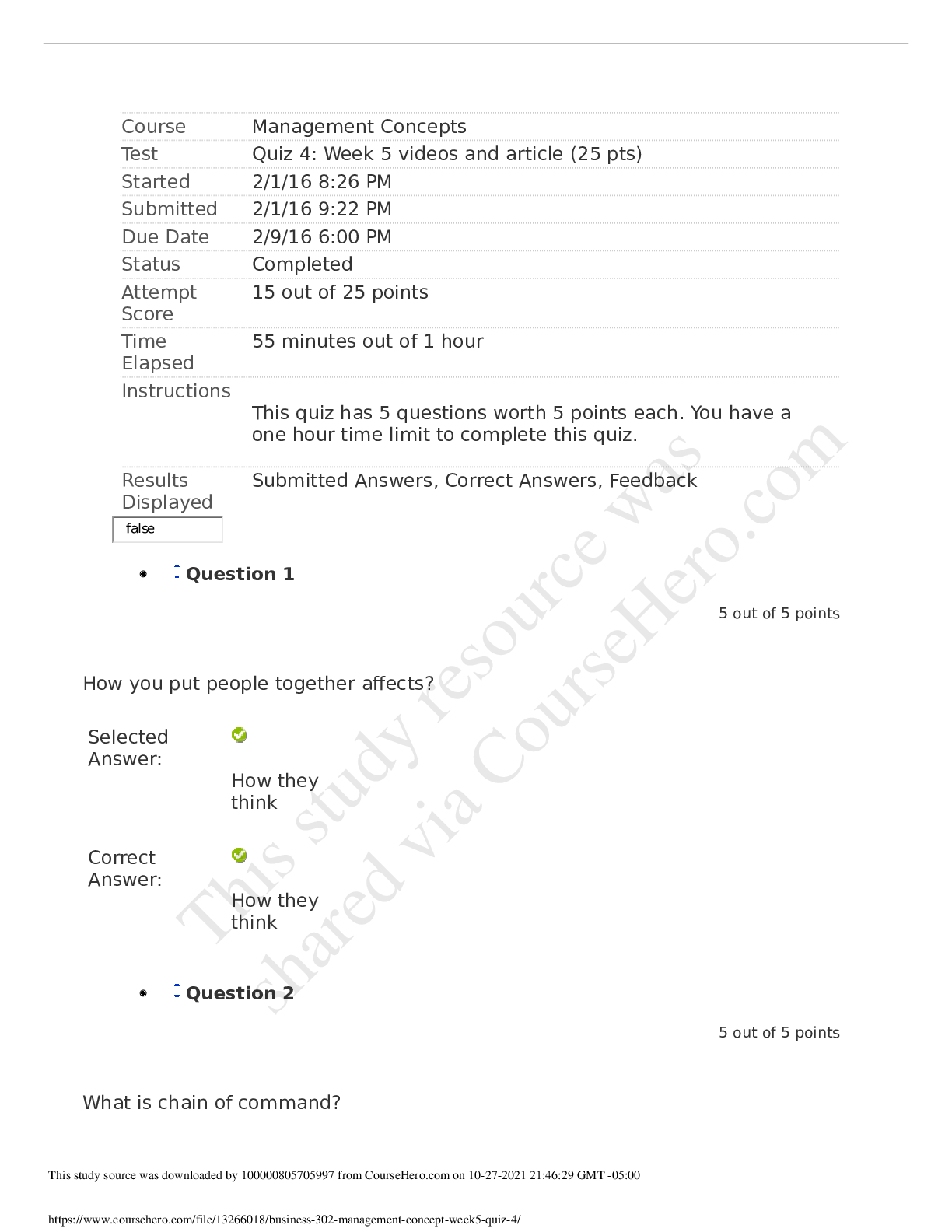

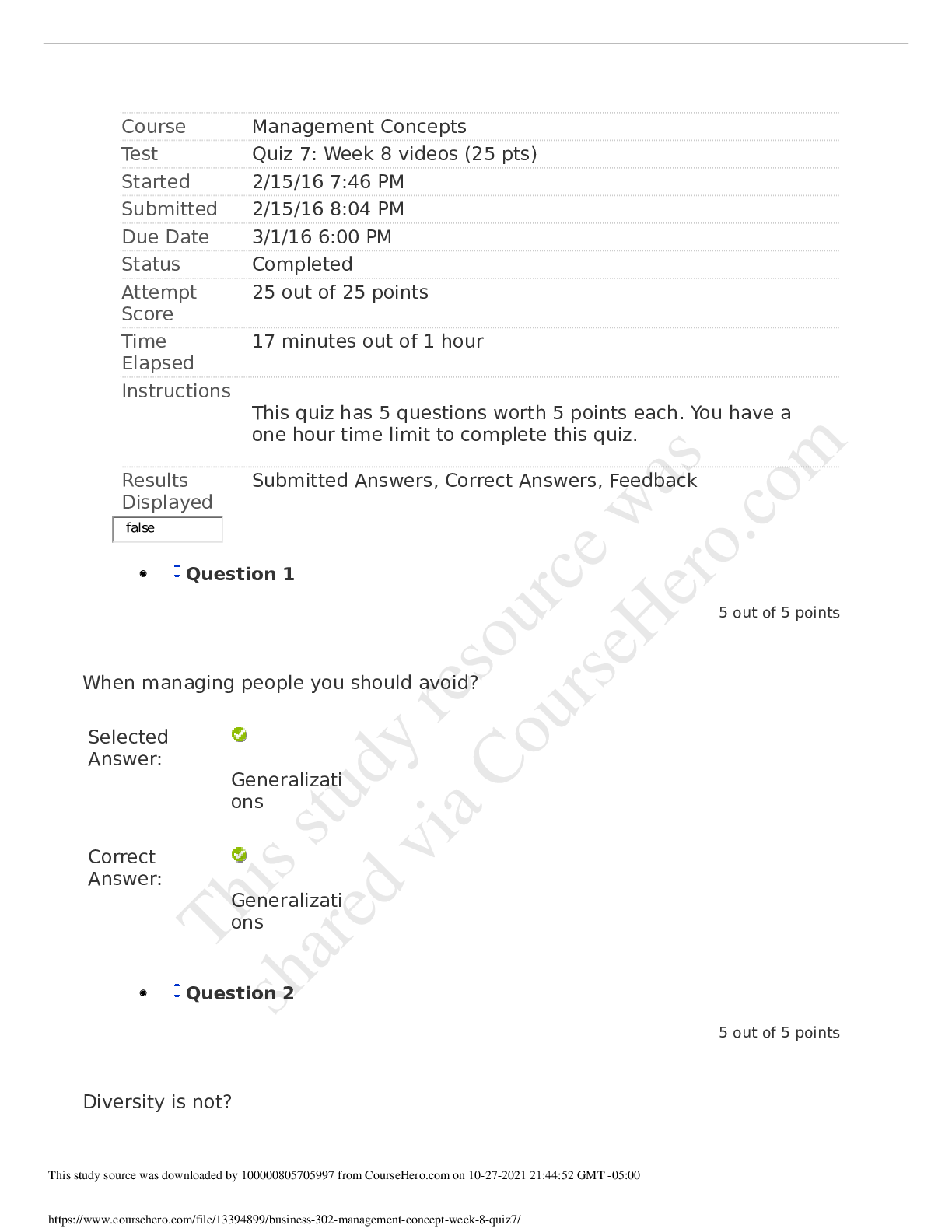

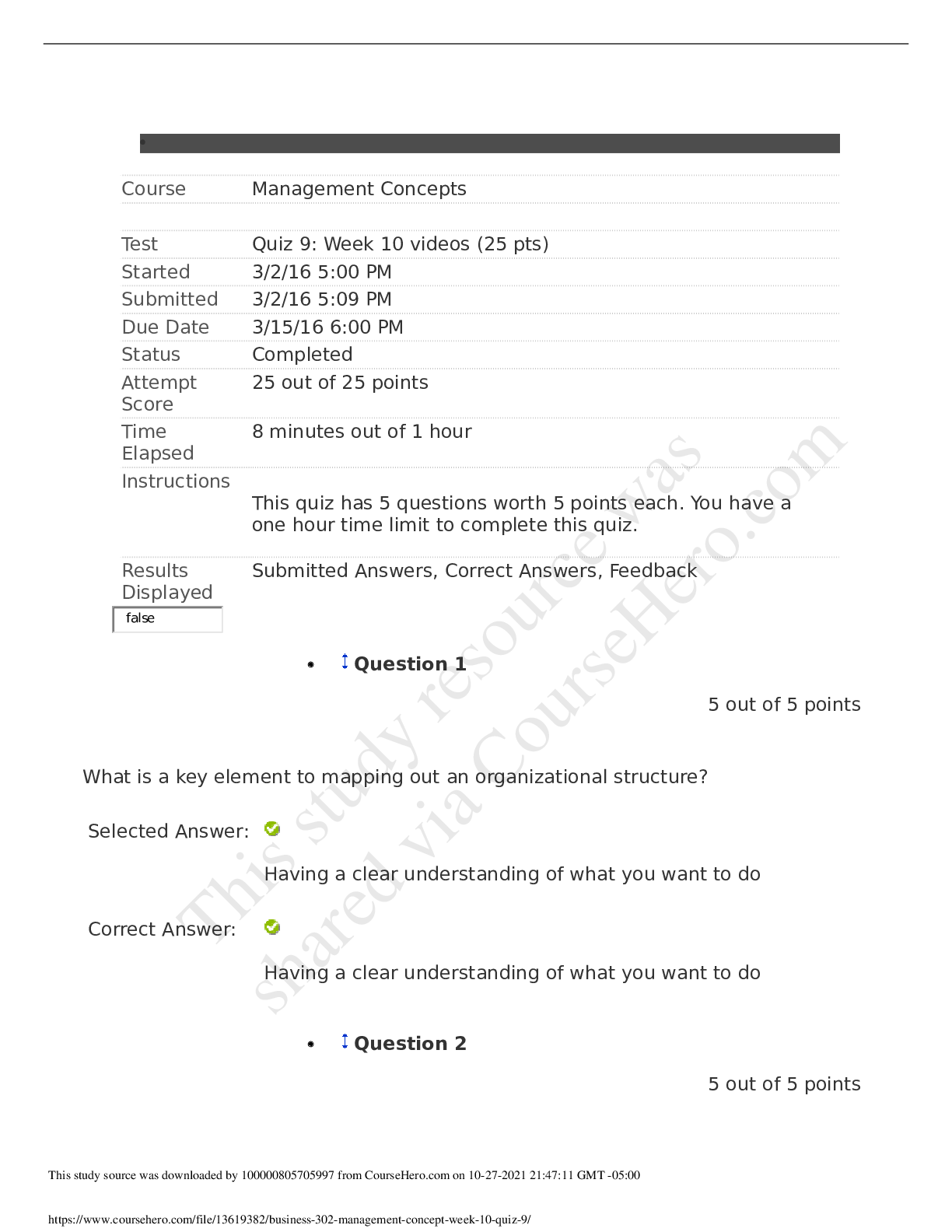


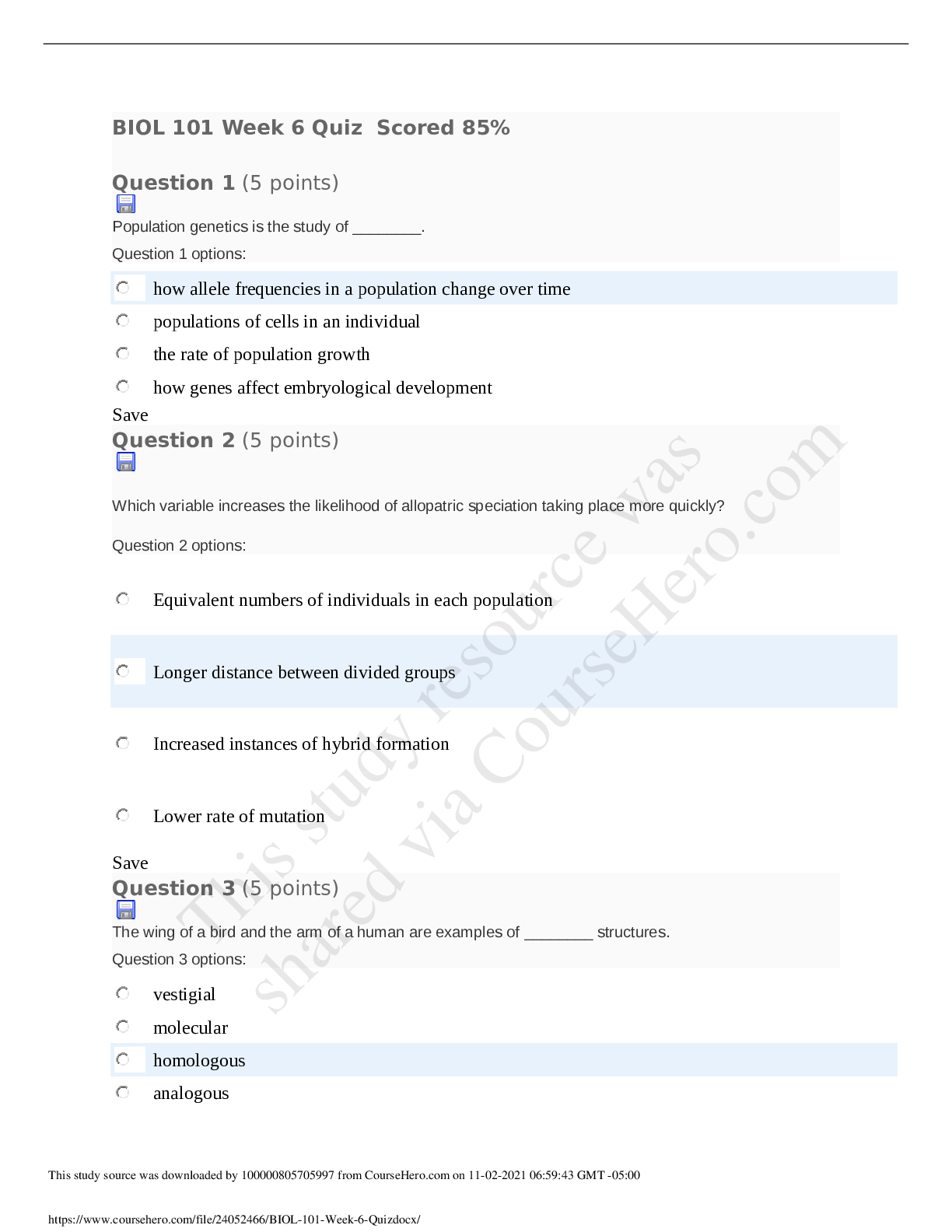

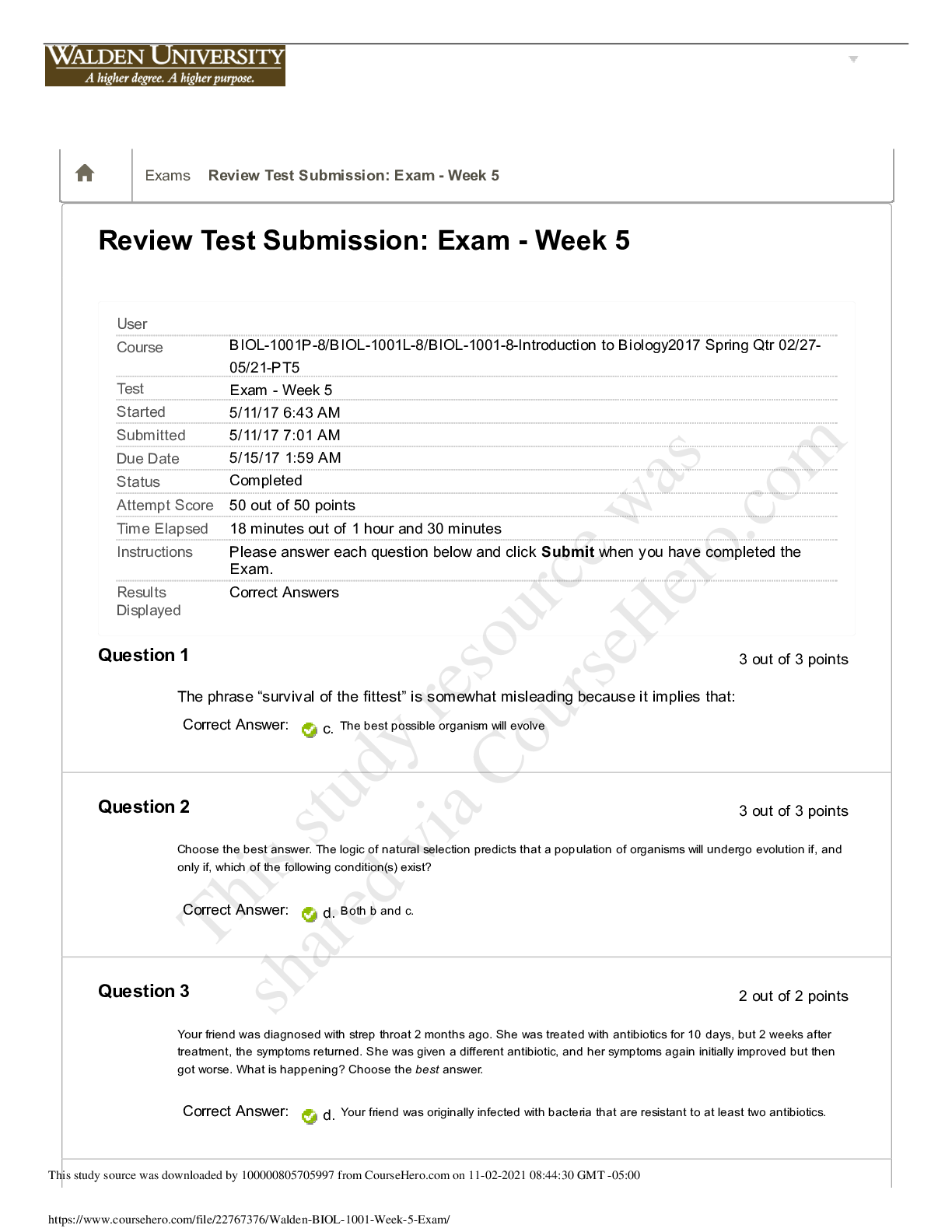

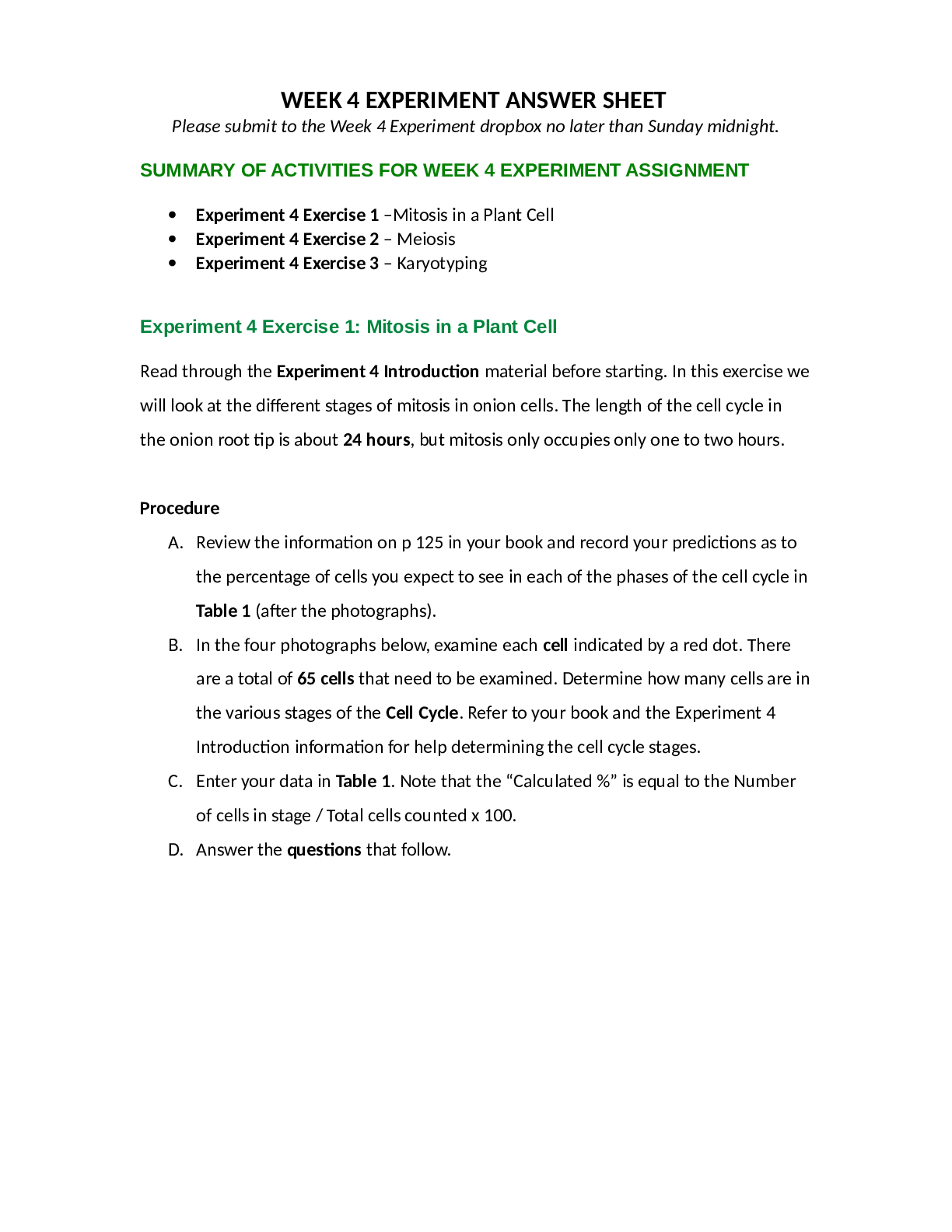
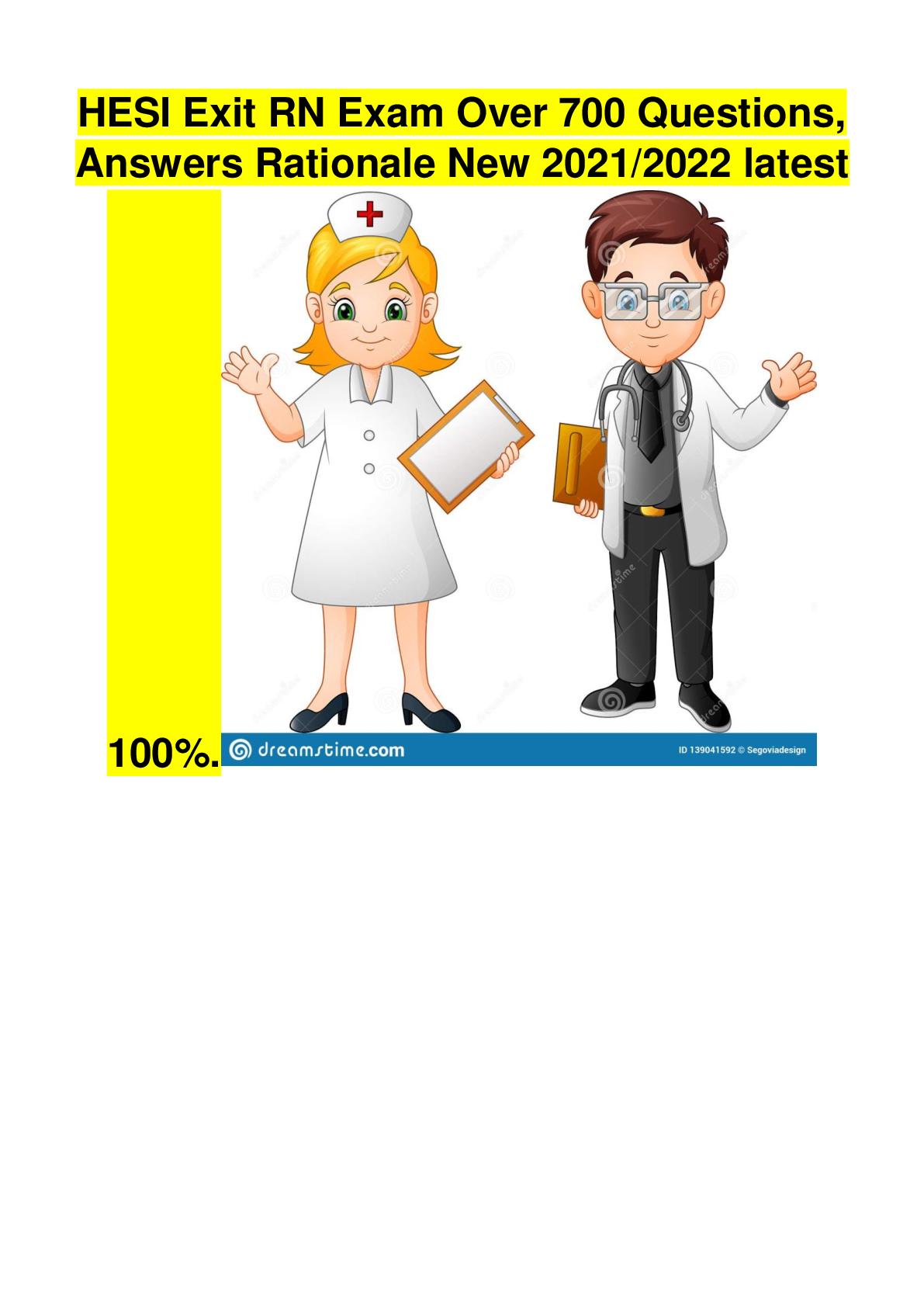
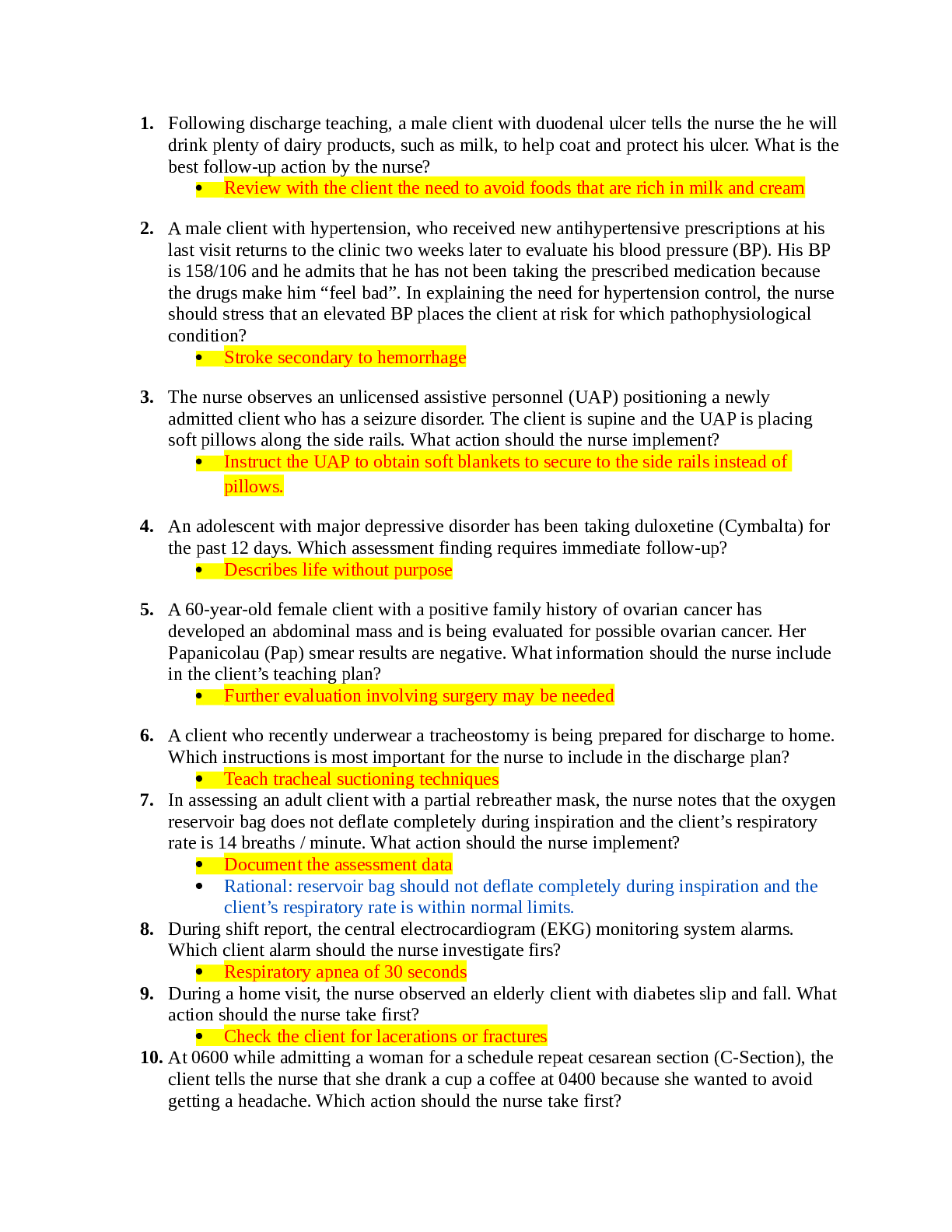
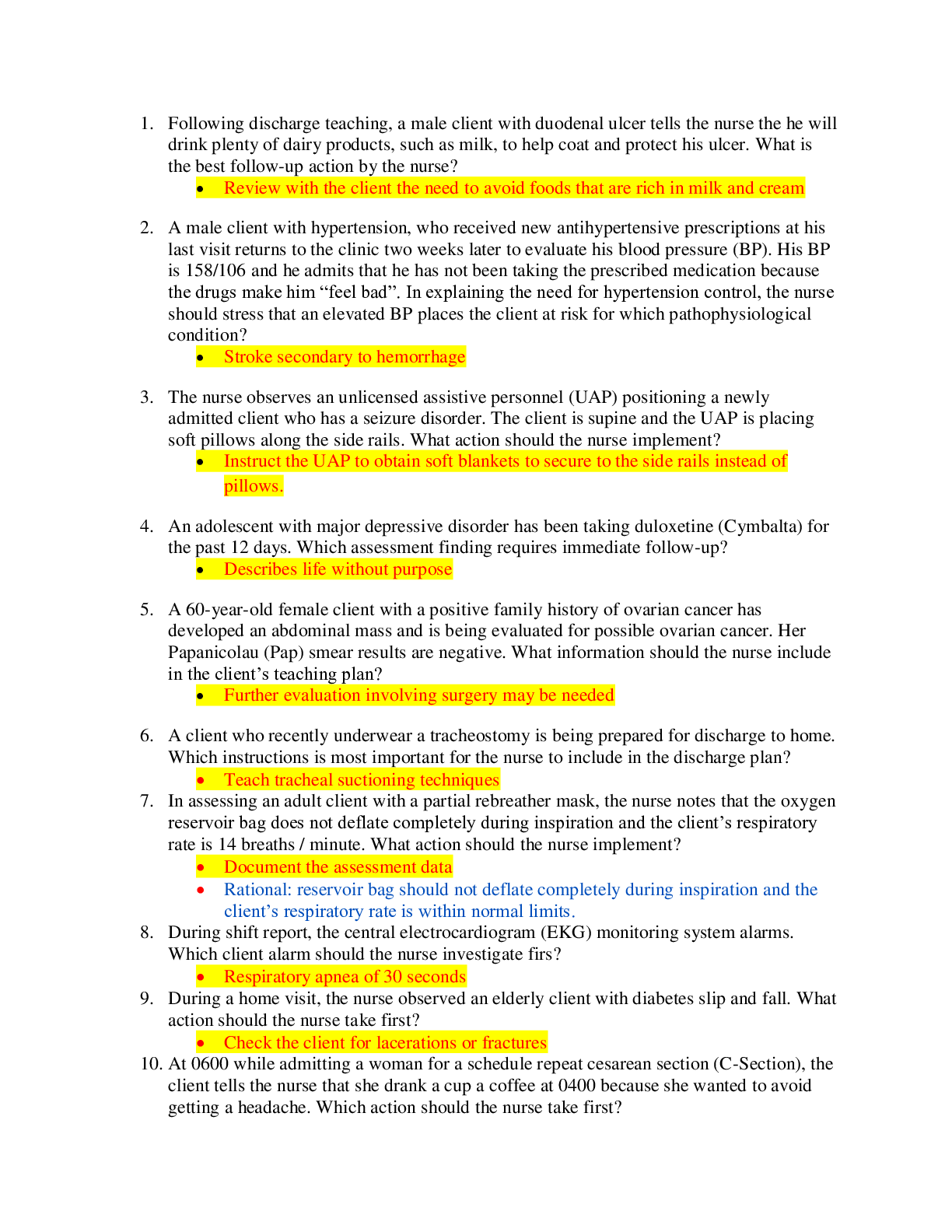
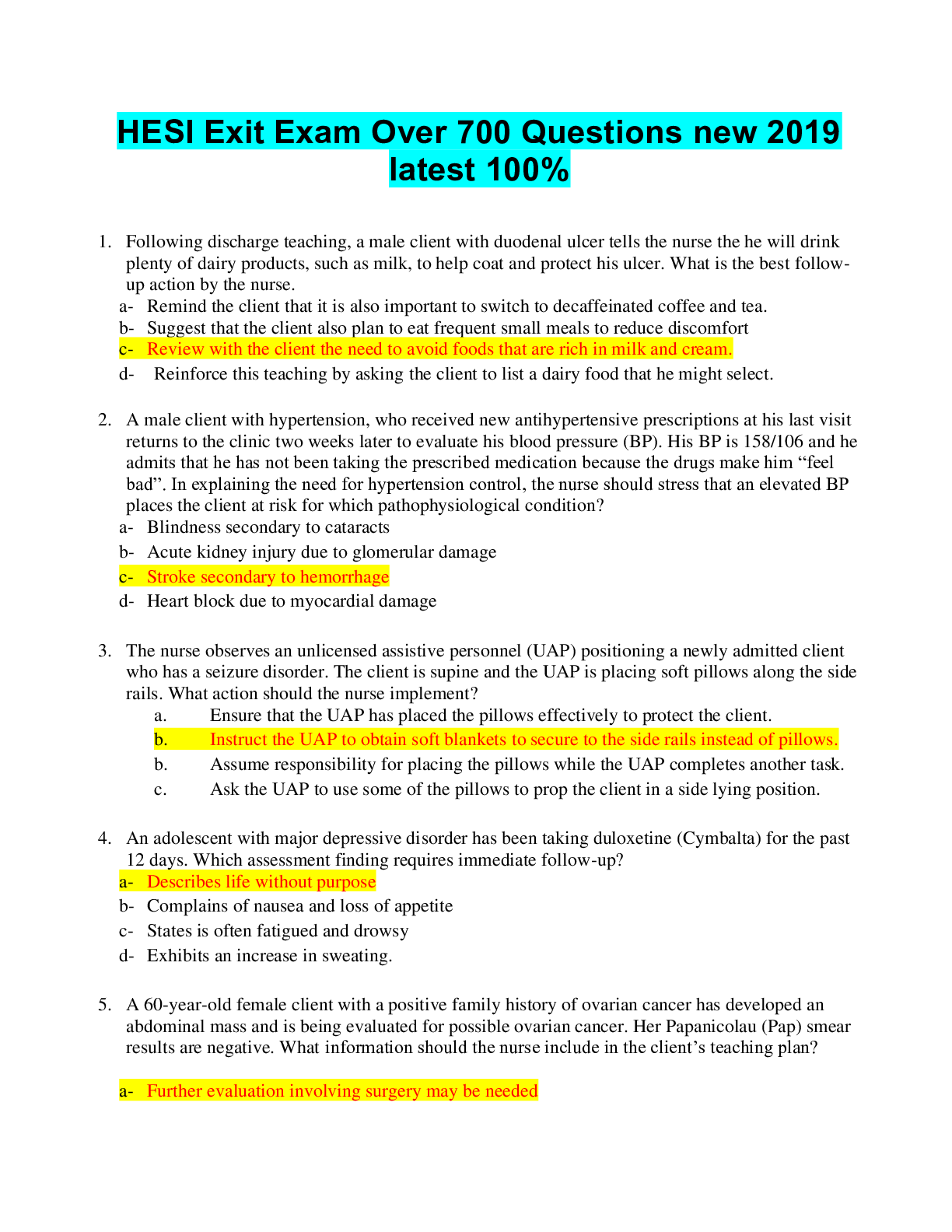
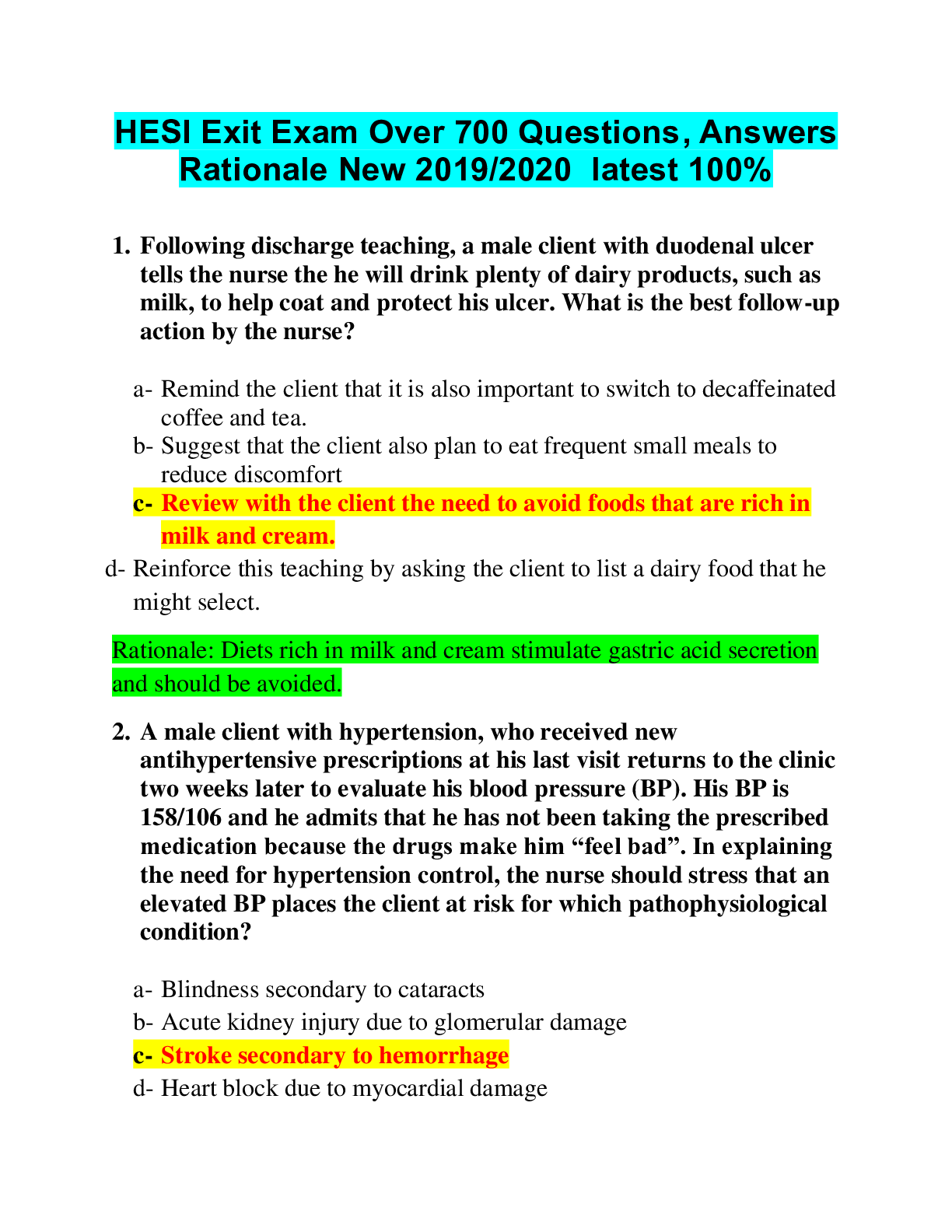


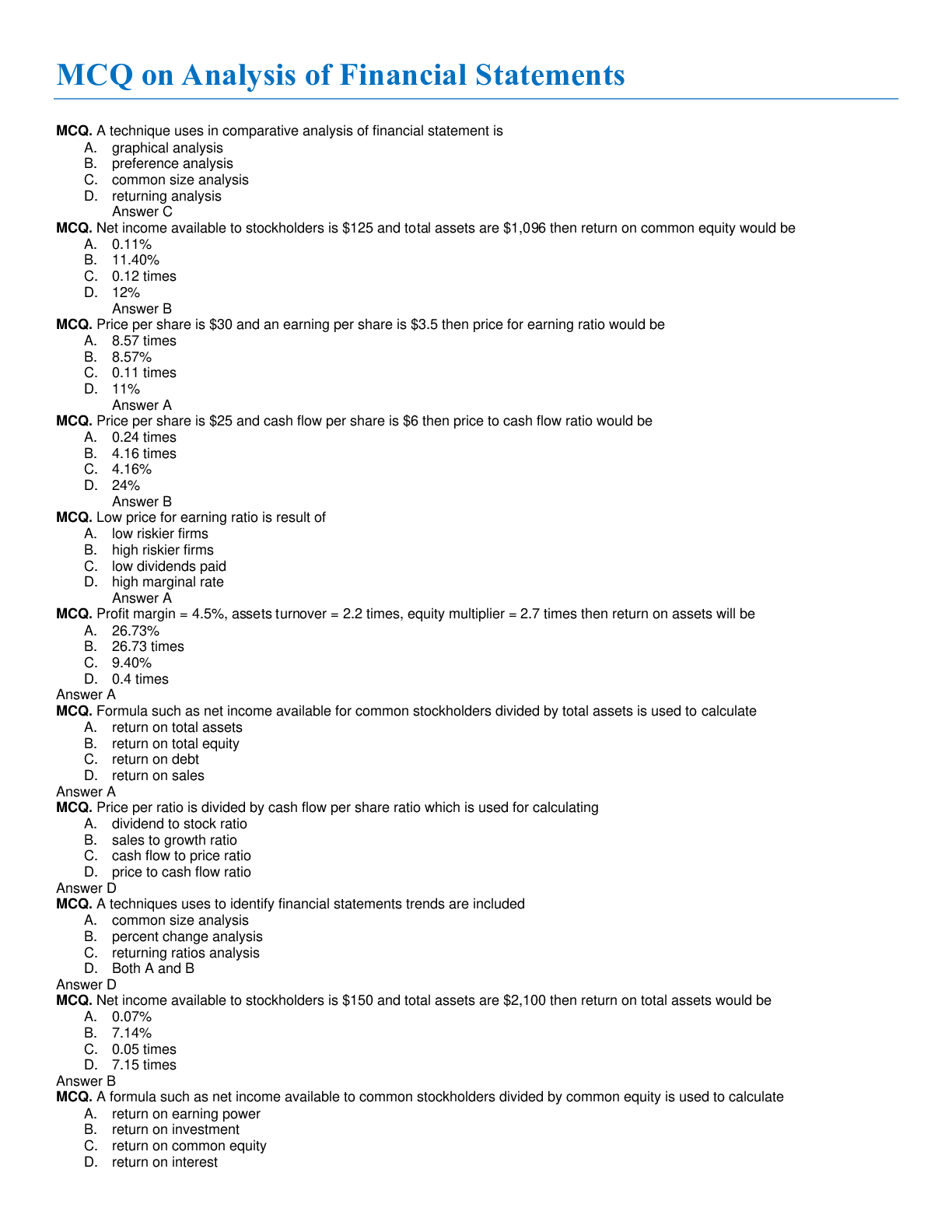

.png)
